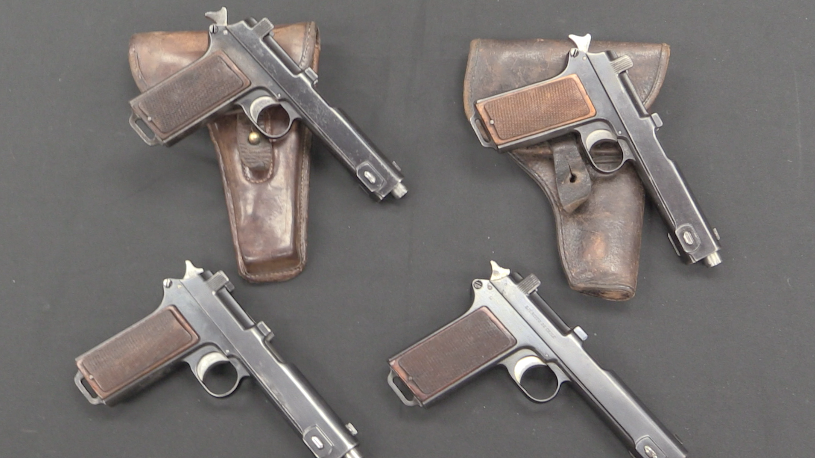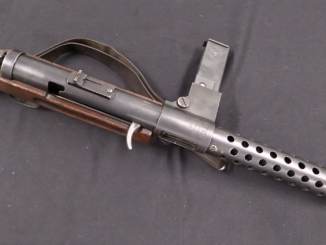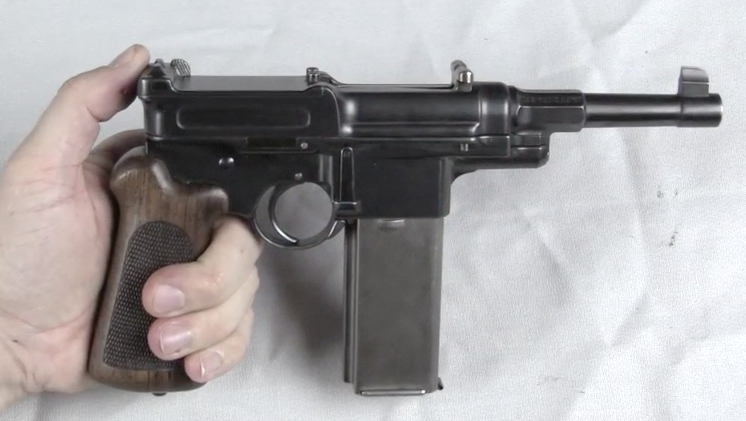The model 1898 Schwarzlose was a self loading pistol definitely ahead of its time. It was simple, powerful (for the period; it was chambered for 7.63mm Mauser), and remarkably ergonomic. It used a short recoil, rotating bolt mechanism to operate, and very cleverly had one single spring which did the duties of primary recoil spring, striker spring, trigger spring, and extractor spring. Why it failed to become a commercial success is a question I have not been able to definitively answer – I suspect it must have been due to cost. Edward Ezell theorizes that it was unable to compete with the Borchardt/Luger and Mauser pistols because those were able to be made with much more economy of scale. It is really a shame, because the Schwarzlose 1898 is the best of all the pre-1900 handguns I have encountered.
Related Articles

Conversion
RIA: Steyr-Hahn Pistol Variations
The Steyr-Hahn is one of the less glamorized pistols used in WWI, despite being made in quite large numbers (250,000-313,000, depending on who you read). The gun is an interesting mix of features, including bits […]

Conversion
A Police SMG Upgrade: the MP-18 System Schmeisser
When the MP-18 was issued by the German Army in World War One, it used the then-in-production Luger “snail drum” magazines. These were expensive, awkward, and generally not ideal. Once the war ended, Hugo Schmeisser […]

Prototype
Mauser 06/08 Semiauto Pistol at James D Julia
Throughout the pre-WWI period, Paul Mauser was working continuously to develop a reliable self-loaiding rifle. Among his many experimental designs was a flapper-locked rifle. The flapper-locking system was first patented by a Swede named Kjellman, […]

A remarkably modern pistol for 1898, indeed. Thank you very much for showing us that video – that’s probably the closest 95% of us would ever get to a Schwarzlose Standard-Pistole.
Did anybody else notice during the slow-motion clips how the rear sight seemed to jump all over the place?
Another great video, thank you, Ian!
Steve M,
I saw it once you mentioned it. I am thinking that maybe the rear sight has springs to keep pressure on it from the bottom. It seems to have easy adjustments right under the sight. If so, the sight would be back where it needed to be by the time you are ready to take the next shot.
Thank you Ian you made my day!
I asked you a long time ago if could make a vid about the Schwarzlose and you did 🙂
Its a very cool gun.
Bravo! I’ve been waiting 43 years (since I first read WHB Smith’s Pistols & Revolvers) for this kind of information. one question: after the barrel and bolt travel back .5″ and then separate, what keeps the barrel in that rearward position? The buffer spring under the barrel must be trying to return it forward, but it stays back until the bolt moves forward and contacts it again.
keep up the great work!
Hi Jim,
take a look at gun broken into parts at bottom of article. No.4 is Barrel holder. Apparently it gets tripped by Bolt on its way forward while both parts proceed forward together and come into battery.
http://ns2.connect.fi/gow/QA17.html
Great, thanks. Its probably worth noting that the extractor is lever extractor, unusual on handguns.
Thank you very much for the video, Ian! Leszek is certainly right. As for the pistol itself, I also always wondered myself why it didn’t become a commercial success, given its simplicity, the well balanced design and the fact that it used a well-proven round. Your video – “This is just a fantastic pistol!” – has reinforced this impression. And I second the suggestion that someone would manufacture a modern reproduction.
“it didn’t become a commercial success”
http://www.pistoletik.net/schwarzlose-m-1898.html
States that Schwarzlose 1898 was late to Mauser C/96 and also Mauser C/96 was more reliable.
It’s a truly simple and elegant pistol firing an effective round I want one.
This is also my much admired design….. and thank you for showing it off!
Great show Ian! I am a 1911 and copy link drop lug lock guy, and have never fired a twist.
Ian mentioned what comes to many of us to mind: why someone does not make a replica (along with Savage in .45cal)?
I am asking same question; firearms design is at its zenith and it is time do return to famous old designs and perhaps make little money in doing so. Let’s hope some start-up company will take on the challenge. No need to waste time inventing things over.
Here is page with detail shots for those who want to see more.
http://www.horstheld.com/0-Schwarzlose.htm
Unfortunately no internals, though.
“Unfortunately no internals”
If you want to see cut-away drawing of Schwarzlose 1898 automatic pistol, see US Patent 712730 A here:
https://www.google.com/patents/US712730?dq=ininventor:%22Andreas+Wilhelm+Schwarzlose%22&hl=en&sa=X&ei=tqRHVfrWB4S9ygPc-ICwCg&ved=0CDMQ6AEwAw
Andreas Schwarzlose also patent “TOGGLE-LINK LOCK FOR RECOIL-LOADING GUNS.” – US patent 804506 A
Thank you Daweo
The pictorials are little tainted with shading which was in vogue at the time, but much of function is visible, including how barrel is kept in rear for feeding. Also as it looks, there in not lots of leeway for compressed main spring or bolt catch; it’s all on pinch. So indeed, the bolt is falling hard on the end stop.
Ian, Ian, Ian. Silly Ian. You don’t know why the C96 Mauser was a commercial success and this gun wasn’t??
It’s simple as pi; Everybody in the late 1890s knew that the C96 was the basis for Han Solo’s blaster! And this, on Tuesday, the FOURTH of May?! (Star Wars Day)
Ha, ha, hope I gave somebody in cyberspace a smile!
Thanks again for all the great videos.
Steve in Arizona
And now, you know too much!
Mauser had more brand recognition in the arms market than Schwarzlose, unless I’m totally wrong. And no, Star Wars did not exist then! Schwarzlose was very bright, though he probably didn’t have much recognition having only recently come into the field at that time while Paul Mauser had lots of successful guns (mostly rifles) on his resume. So whose gun would you take, the guy who’s had at least two wars under his belt or the guy who “just got out of gun-smith apprenticeship” and has set up shop “with no idea what to make?”
It doesn’t look particularly more expensive to make than other comparable pistols of the same era. The lack of sales may be related to reliability problems that won’t be apparent unless you fire a lot of rounds through it, or it may be due to the fiddly disassembly procedure.
It may also be simply due to the commercial situation of the company which had nothing to do with the pistol itself. He may have decided to focus on his machine gun design, which I believe was meeting some success at about that time.
Ians’ hands look strange in slow motion.
Those aren’t actually my hands in the slow motion shots. 🙂
As Leszek Erenfeicht already said, a great video of an extremely rare pistol. Thank you very much for sharing it.
By the way, Andreas Scharzlose is correctly pronounced by you.
The feature I like is knowing that the firing pin is protruding and ready to go. We have metals that will NEVER shear these days for the retaining pin.
Thanks a lot for showing the internals of this remarkable pistol. Am I right to assume that something keeps the barrel at its rearmost position, until the rotating bolt is in place, so they can travel along forward together?
There was replica(well sort of…) of that pistol – AMT Automag 😉
IIRC, some later models(III and probably II) were using magazine follower springs of similiar construction(but same goes for rimfire rugers, DE and some others).
From all indications, the original Harry Sanford/Max Gera AutoMag was based on the High Standard made (Grant) Hammond .45 pistol of 1910 or so. Only about a dozen were made for the second round of U.S. Army trials, and like the Savage the Hammond lost out to the Colt on reliability.
I don’t know exactly what connection there might be between the Schwarzlose and the Hammond, but both have rotating bolt lockups and multiple lug bolt heads. The Hammond has an external hammer searage rather than a spring-driven striker. I’ve always thought the Schwarzlose searage/striker setup was derived from the Mauser bolt-action rifle system, or possibly the Austrian Mannlicher.
BTW, anyone who worries about that bolt/slide group retaining “loop” should consider that the bolt retainer/recoil spring block in the Mauser C/96 barrel extension can shear, too. And if it does, you’ll probably get that rectangular bolt right up your nose.
The AutoMag has a crosspin in a large “ring” forged integrally with the frame, that both rotates its bolt (like the Schwarzlose) and retains the bolt along with the twin recoil spring rods. The barrel extension also has the block at the front of the frame that the (Lahti-like)”accelerator” lives in, that abuts the frame much like the front barrel-extension block on the P.08 (Luger).
To have a bolt-blowout failure on the AutoMag, four different pieces would have to shear or fracture. Even with a pistol firing Magnum-level ammunition, that’s not likely to happen “all at once”. Something is going to give first, and that should be enough warning to take the gun out of service before a catastrophic failure.
I think that ultimately, the Schwarzlose failed for the same reason the AutoMag did. That being that there was no economical way to manufacture it and sell it for a competitive price.
These days, with computer-operated manufacture, 3D “printing” , and etc., it might be a different story.
cheers
eon
Schwartzlose actualy…
Very interesting pistol and always low information on it until now Ian,thanks..
As TomTB pointed out the two failure pieces looked fairly easy to have 21th century materials pieces made.
The rear sight looked adjustable, did it go out to the traditional beyond optimistic distance?
The loop shaped post at rear of Scwarzlose has several functions; The outside of ring functions as a guide for breechbolt reciprocal movement; the inside opening with bottom tip functions as a guide for striker; the short post between loop and base functions as
rotater for locking lugs; and the front of this post, oval shaped to counterfit the slot provided at bottom of breechbolt acts as bolt stopper. This forwarding bottom section of loop takes all the stress of impact of recoiling breechbolt as saving the upper sections since no forcing effects but some friction occur through those areas. The leverage is least at impact area and whole loop is made of a seperate, more durable and special heat
treated material. Therefore, This pistol is safer than thought by most.
It’s probably at least as safe as the Japanese Type 14 8 x 21mm “Nambu”. Its bolt is retained by two semicircular “nubs” forged into the rear of the upper frame section, that act as bolt guides by riding in slots machined into the sides of the bolt. The slots end about 1/4″ short of the bolt head, which acts as the bolt rear stop. Generally, the nubs only abut the slot ends at full recoil.
If either nub would shear under load, the other one might still keep the bolt in place. If both were to shear, simultaneously or one after the other, the bolt would almost certainly hit the shooter in the face assuming a normal shooting stance.
For real fun, examine a Kimball blowback auto in .30 Carbine sometime. Two small blocks at the rear of the frame retain the short .22 blowback-style slide in recoil. It is rare to see a Kimball with both of the blocks still present.
The Schwarzlose is probably a good deal safer, if for no other reason than that the proper heat-treatment of a small separate piece is much easier than the proper heat treatment of an entire pistol frame.
cheers
eon
I’m a worry wart, but given the opportunity I would shoot this gun. For being a rather light bolt, bolt speed doesn’t seem real high. With the stop below the center of mass, some bolt tilt is inevitable, and seems to be arrested in the front by the tops of the guide lugs in the frame rails. In the rear, I’m not so sure. The preview photograph in March showed operating marks (maybe?) on the bottom of the bolt approximately 1 groove width behind the front of the operating groove. To me it looks as if the bolt makes contact with the rear of the frame, but slightly after counter recoil has started the bolt forward. Whether the interior of the bolt peens at the top of the bolt guide ring, I can’t tell. Bolt tilt is common and perhaps this is well within normal, What I would be concerned about is not shearing off of the bolt stop, but a repeated flexing and work hardening of the base of the guide ring.
Dear sir: 1) Were you able to extract unfired cartridges? Hogg says in his book that the extractor only engaged when the firing pin was released. 2) In case of misfire, could the striker be separately cocked for a second strike? 3) Was accuracy acceptable or did barrel wear make this a moot point? 4) It seems to me that the stop on the barrel return spring would absorb a lot of force before the bolt began moving backwards, thus reducing the risk of bolt stop shear. Any thoughts? Thank you for this look at an amazing piece of hardware, and assuaging three decades of curiosity.
Dear Mr. McCollum, thank you so much for posting this video. I’m currently fighting through the necessary paperwork to get a German collector’s license for firearms, with the topic on “locking systems in German semi-auto handguns”. There is not much information about the Schwarzlose 1898 in the web, until now. Best regards from Bavaria, Mike
Ian thanks for the vidio. It does look very modern. However I very much doubt a reprodution will ever be made because of liability around that pin and back part you pointed out given out suite happy society. Too bad.
Still hoping for answers to my questions above; so many other guns have floated under the bridge, sigh ….
You know, I’ve been getting stumped by this pistol left and right. I know it’s chambered in 7.62 mauser but I’m also aware that some, one in particular, was converted to fire a 9mm cartridge but I cannot for the life of me figure out which one and the website that showed it said it was an unknown 9mm. My best guesses would be the 9mm luger or the 9mm mauser export cartridge. Can someone give me a hand in confirming or disproving this please?
I believe I saw that piece listed on an auction website and they listed it in 9mm; and in my memory they seemed to indicate that they believed it was a private after-sale conversion. I doubt anyone would chamber it in 9×25 Mauser, the cartridge being both rare-ish and very powerful. I am still wondering if the original chambering was 7.65 Borchardt or 7.63 Mauser, because the reference authors seem to disagree on that point, and of course the two cartridges were dimensionally identical. Mr. McC. shot Mauser cartridges out of it at modern (somewhat weak?) loadings, and the action seems strong enough for the hotter Mauser round.